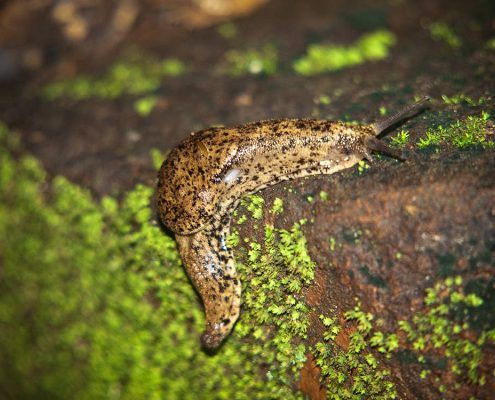
Rat Lungworm Disease in Hawai’i
What Is Rat Lungworm Disease?
Maui is a beautifully diverse island that sees visitors from all over the world enjoying the warm weather and wonderful beaches. However this transient economy brings in invasive species that can become a concern in a very short time. This is the case with an invasive slug that has brought a new and scare sounding threat – rat lungworm disease.
Learn how the community of Hana is taking action to prevent spread.
Rat lungworms are a roundworm parasite found in rodents, mostly rats – hence the name. The worm develops to maturity in the lungs of the rodent. When rodents expel the larvae of the worm through excretions they can become ingested by snails, slugs, land crabs and frogs; these are considered intermediate hosts. The larvae can reach humans when people consuming (whether intentionally or otherwise) these animals raw or through eating raw foods or liquids contaminated by them. However humans are a dead end host. The parasite will not develop to sexual maturity in humans but may live for up to a year in the human body until eventually dying.
The disease has been seen in Southeast Asia and tropical islands throughout the Pacific for decades including Africa, the Caribbean and the southern U.S. According to the U.S Center for Disease Control and Prevention it’s occurrence is rare and most people completely recover without treatment.
State of Hawaii Department of Health describes it as;
“Angiostrongyliasis, also known as rat lungworm, is a disease that affects the brain and spinal cord. It is caused by a parasitic nematode (roundworm parasite) called Angiostrongylus cantonensis. The adult form of A. cantonensis is only found in rodents.”
However, infected rodents can pass larvae of the worm in their feces. Snails, slugs, and certain other animals (including freshwater shrimp, land crabs, and frogs) can become infected by ingesting this larvae; these are considered intermediate hosts. Humans can become infected with A. cantonensis if they eat (intentionally or otherwise) a raw or undercooked infected intermediate host, thereby ingesting the parasite”.
Rat Lungworm Disease Symptoms
According to the Center for Disease Control humans are accidental hosts who do not transmit infection to others. Symptoms can range from mild headaches to burning & tingling sensations in the skin. Severe cases can even cause temporary paralysis, debilitating pain throughout the body, and in very rare cases even death. It is thought the parasite enters the bloodstream and becomes confused when in the human body rather than a rat. It then settles in the brain and spinal cord. Some doctors have reported the parasite can also settle in the eye where it can affect eyesight. However if in the eye it can possibly be removed by surgery.
The Hawaii Department of Health describes it this way:
“This infection can cause a rare type of meningitis (eosinophilic meningitis). Some infected people don’t have any symptoms or only have mild symptoms; in some other infected people the symptoms can be much more severe. When symptoms are present, they can include severe headache and stiffness of the neck, tingling or painful feelings in the skin or extremities, low-grade fever, nausea, and vomiting. Sometimes, a temporary paralysis of the face may also be present, as well as light sensitivity. The symptoms usually start 1 to 3 weeks after exposure to the parasite, but have been known to range anywhere from 1 day to as long as 6 weeks after exposure. Although it varies from case to case, the symptoms usually last between 2–8 weeks; symptoms have been reported to last for longer periods of time“.
The Center for Disease Control gives this description;
“Humans are accidental hosts who do not transmit infection to others. Most cases of infection are diagnosed in Southeast Asia and the Pacific Basin, but the parasite has also been found in Australia, some areas of Africa, the Caribbean, Hawaii and Louisiana. Outbreaks of human angiostrongyliasis have involved a few to hundreds of persons; over 2,800 cases have been reported in the literature from approximately 30 countries. It is likely that the parasite has been spread by rats transported on ships and by the introduction of mollusks such as the giant African land snail (Achatina fulica). In addition, the semi-slug, Parmarion martensi (native of Southeast Asia) has spread in regions of Hawaii and is found to often be infected with A. cantonensis”.
Other animals that become infected such as freshwater shrimp, land crabs, and frogs are transport hosts that are not required for reproduction of the parasite but might be able to transmit infection to humans if eaten raw or undercooked.
Getting A Diagnosis
of Rat Lungworm Disease
Because of the varying symptoms that can seem like other mild illnesses this type of meningitis can be hard to detect. The only way to know for sure is to do a lumbar puncture, also known as a spinal tap. Spinal fluid is removed and tested to determine the presence of eosinophilic meningitis. Hawai’i doctors are familiar with this disease but most mainland doctors may not.
Hawaii State Department of health says;
“Diagnosing angiostrongyliasis can be difficult, as there are no readily available blood tests. In Hawaii, cases can be diagnosed with a polymerase chain reaction (PCR) test, performed by the State Laboratories Division, that detects A. cantonensis DNA in patients’ cerebrospinal fluid (CSF) or other tissue. However, more frequently diagnosis is based on a patient’s exposure history (such as if they have history of travel to areas where the parasite is known to be found or history of ingestion of raw or undercooked snails, slugs, or other animals known to carry the parasite) and their clinical signs and symptoms consistent with angiostrongyliasis as well as laboratory finding of eosinophils (a special type of white blood cell) in their CSF. There is no reliable diagnostic test available to detect previous infections of angiostrongyliasis.“
Prevent Rat Lungworm Disease
The best way to avoid rat lungworm is to thoroughly wash fruits and vegetables, especially leafy greens like lettuce, as small slugs can become hidden at the base of the leaves. The surface of leafy veggies can also become contaminated from the mucus secretions left behind by slugs and snails. Do not handle slugs with your bare hands – especially children.
Hawai’i residents in infected areas have been working to eliminate invasive snails, slugs and rats found near gardens and houses. There are more cases on the island of Hawai’i than there are in Hana. All residents of the Hana side of Maui are fully aware of the threat and are coming together as a community to keep themselves and visitors safe from this debilitating disease. We love this community as they immediately help their neighbors without funds from the county or state to take preventative action, care for those affected and educate thru the schools.
Hawaii Department of Health recommendations;
“To prevent angiostrongyliasis (rat lungworm disease), don’t eat raw or undercooked snails or slugs, and if you handle snails or slugs, be sure to wear gloves and wash your hands. Eating raw or undercooked freshwater shrimp, land crabs and frogs may also result in infection, although, there has not been any documented cases in Hawaii. You should also thoroughly inspect and rinse produce, especially leafy greens, in potable water, and boil snails, freshwater prawns, crabs, and frogs for at least 3–5 minutes. Eliminating snails, slugs, and rats founds near houses and gardens might also help reduce risk exposure to A. cantonensis.”
Treatment For Humans
Keep Your Immune System Strong
How do you get rid of rat lungworm disease? The answer is not comforting. It really comes down to your personal level of health and strength of an individuals immune system.
Hawaii State Department of Health says;
“There is no specific treatment for the disease. The parasites cannot mature or reproduce in humans and will die eventually. Supportive treatment and pain medications can be given to relieve the symptoms, and some patients are treated with steroids. No anti-parasitic drugs have been shown to be effective in treating angiostrongyliasis, and there is concern that they could actually make the symptoms worse because of the body’s response to potentially more rapidly dying worms. Persons with symptoms should consult their healthcare provider for more information.”
The Probable Problem – Semi Slugs
Not much is known about the extent of the infestation of this tiny slug in Hawai’i Island and Maui other than that the cases only seem to occur in the wet, humid and rainforest areas of these islands.
The semi slug favors wet tropical conditions which are the hallmark of the rainforest covered side of Hana. The species has been infesting the Big Island for years but has now made it’s way to Hana.
Studies show the rat lungworm parasite has been known to occur in about 50% of the population of rats and the intermediate hosts of slugs and snails found on the wet windward sides of the Big Island of Hawai’i. However semi slugs have been shown to carry the parasite about 75% to 80% of the time. This has caused concern on the Big Island where over the last five years 3 to 5 cases of the disease have occurred annually.
Semi slugs are land gastropods whose shells are too small for them to retract into. The shell of some semi-slugs may not be easily visible because the shell may be covered over with a fleshy mantle.
This is a type of gastropod that is an intermediate between a slug (without an external shell) and a land snail (with a large enough shell to retract completely into) hence the name “semi”.
There exist a number of gastropod families that have semi-slugs species. There exist about 1000 species of semi-slugs in comparison to about only 500 species of slugs.
The semi slug seems to be less active in the hotter summer season but tiny babies appear in the fall and they too can carry the rat lungworm parasite. The slugs love the food we and our pets eat. They can crawl up walls and into homes leaving parasites in their slime trails. They will get into compost bins, trash cans, crawl under tarps, weed cloth, plastic and plastic plant pots. They appear soon after food sources become available, including pet foods. A very small piece of slug can contain as many as a thousand parasites.
Perhaps the most concern many Hana residents have is the slugs ability to crawl into water systems or catchment tanks where the slug will drown and release parasites which can survive up to 72 hours in the water.
Rat Lungworm Disease In Hawai’i
Hawai’i has seen the same number of infections so far this year as it has in past years. So far eleven cases have been confirmed (April 2017) – six on Maui and five on Hawaii Island. Overall there are way more cases on Hawai’i Island than there are in Hana.
Scientist believe this parasite first arrived in Hawai’i many years ago via infected rats from southeast Asia. This parasitic nematode (worm) is transmitted between rats and mollusks (slugs and snails) who feed on the rat droppings. The main theory is that the parasite can be transferred to humans who eat raw leafy unwashed vegetables like lettuce that contain these small slugs or possibly the slime trails they leave behind. On the Big Island several cases were known to come from a kava beverages left outside that slugs crawled into, contaminating the beverage that people then drank from.
Maui Cases
Six cases of the disease have been diagnosed this year (2017) from people living or visiting the Hana side of the Maui. These occurrences are new to Maui and have caused quite an online stir. National coverage of the problem has brought to light a rare but scary parasite that has residents and visitors on edge. Many believe the main reason can be found in a tiny invasive species – the semi slug.
The Maui News reports that “Six cases of rat lungworm have been reported on Maui over the past three months (February thru April 2017) — tripling the amount of cases the island has seen in the past decade, Maui District Health Officer Dr. Lorrin Pang said.
The report continues with the account of a Hana resident;
Hana resident Kawika Kaina said his family friend, a teacher at Kamehameha Schools Maui, contracted rat lungworm disease in March (2017) and said she is experiencing tremendous pain and uses a walker due to the damage from the parasite.
The resident teacher was born and raised in Hana, and her diagnosis shocked the community, Kaina said.
“I’ll be honest, my greens intake has definitely dwindled below the five-a-day level,” Kaina said. “That’s not because I don’t like greens, that’s just because we don’t want to eat anything raw.
“I have four children of my own so I’ve definitely shied them away from lettuce.”
Kaina placed slug bait across 9 acres of his property on Tuesday after discovering about a dozen semi-slugs in his ti leaves, pohole (fiddlehead fern) and other plants the day before. He even found a slug in his shower Tuesday morning that may have climbed up the pipes.
“It’s everywhere,” he said. “My paranoia level as far as rat lungworm is really up there.”
Aside from Hana residents two visitors have also been diagnosed. A California couple from the Bay Area contracted the disease around March of 2017. Here is an excerpt of their interview from NBC News Bay Area:
“It never occurred to us that our honeymoon would be two weeks in paradise to return home with worms in our brains,” Ben Manilla of San Francisco, a journalism professor at UC Berkeley, said in an email after spending a month in the hospital, undergoing several operations and suffering complications.
Manilla said had he and his wife, Eliza Lape, known about the disease, they would have more thoroughly cleaned fruits and vegetables. They believe they contracted it in the remote Hana area of Maui early this year.
“My symptoms started growing to feeling like somebody was taking a hot knife and just stabbing me in different parts of my body,” Lape told the Honolulu news station.
Still, the couple can’t wait to return to Hana, Manilla said.
“We’ll do it a bit differently next time knowing what we know now about rat lungworm disease,” he wrote.
Hawai’i Island Cases
Two adults on the Big Island got the disease (2017) after consuming a contaminated homemade beverage, health officials said last week. They left homemade kava, a cultural dietary supplement, in uncovered buckets overnight. After transferring it into bowls and consuming it they noticed slugs in the bottom of the bowl after drinking it, Dr. Virginia Pressler, director of the state health department said. Four others who drank the same batch are suspected of being infected.
CNN recently published a report about a young man who contracted the illness:
Graham McCumber contracted the disease in 2009. It is unclear how he became infected, though symptoms began when he was visiting the Big Island of Hawaii.Before he got sick the 24 year old was an avid surfer and skateboarder and worked as a carpenter and stonemason. He was strong, athletic and had his whole life ahead of him. Then he got sick with rat lungworm. The parasites attacked his nervous system and brain causing severe inflammation that led to coma.
Though the doctors predicted that Graham’s brain damage was so great he would never recover, 9 months after becoming sick with rat lungworm, he is walking, talking, eating and living. Because of damage to the brainstem and cerebellum and weakness from 3 months in a coma he has had to relearn how to use his body. His eyesight was affected and his left eye turned completely inward from damage to nerves controlling to the ocular muscle, causing double vision. This issue is slowly reversing itself but he still has double vision, which adds to his problems with balance. Every major organ in his body was affected, which has caused a host of other problems. Even his vocal chords and voice was affected.
Graham’s mother said “We have met many people who have had the disease and the majority of them still suffer from symptoms caused by neurological damage inflicted by the parasite; some are still on morphine as the pain is still so great even years later. I cannot emphasize strongly enough that you do not want to get rat lungworm!
Commitment To Guest Safety
Hopefully we have shared this information as clearly and honestly as possible. The problem is ongoing but rest assured this is by no means a reason not to visit Hawai’i. This disease is still rare and the precautions mentioned above should keep people safe from the harmful effects of this parasite.
All food on our tours, including our Hana Tour, come from sources in central Maui and we use no produce from Hana in our breakfast or lunches. Mahalo for taking the time to learn about this problem and be sure to implement the ways to avoid it.
Aloha Nui Loa












